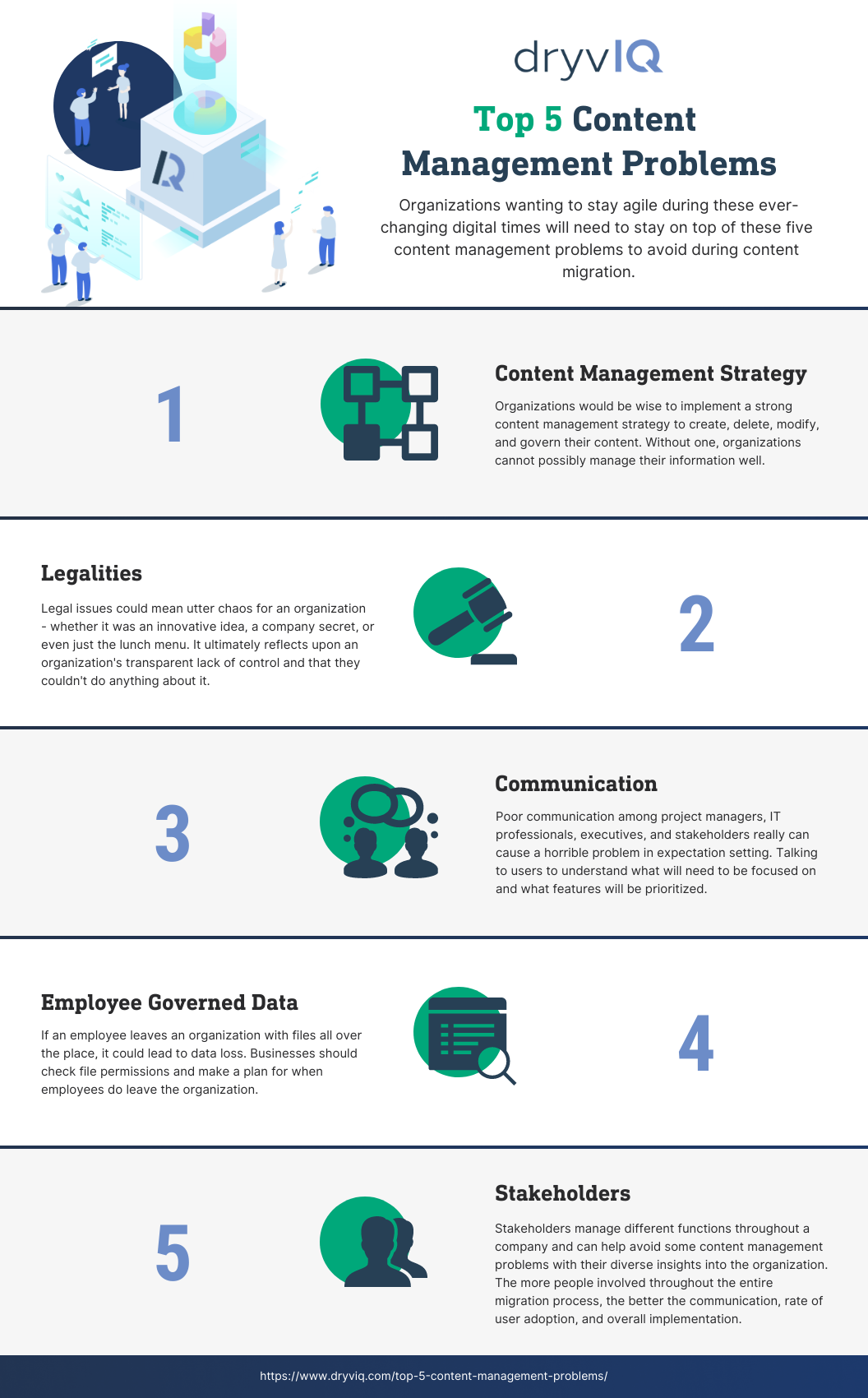More Data, More Content Management Problems
These days businesses are creating more data than ever before. According to Forbes, 90% of all of the data generated in the world was made just over the last two years. Of course with more data and content comes more management, governance, and therefore more potential problems. When managing massive amounts of content, it can be stressful to consider all of the issues that could arise, causing some frustrating content management problems.
Top 5 Content Management Issues
Organizations that want to stay agile during these ever-changing digital times will need to stay on top of these five content management problems to avoid during your content migration:
Lack of Content Management Strategy
Organizations would be wise to implement a strong content management strategy to create, delete, modify, and govern their content. Without one, organizations, especially those with huge amounts of data, cannot possibly manage their information well. But with one, organizations can effectively manage their data to minimize the threat of data loss or leaked content.
Therefore content analysis is imperative to any good content management strategy. Often organizations moving from on-premises to the cloud, for example, want to simply lift and shift all of their content without first truly understanding what’s there. This could result in a waste of resources and can negatively impact the migration project and user experience.
Legalities
One of the biggest content management problems in business is that something leaked to the public. The organization may have no idea where it came from, where it went, and it could even go to press. This could mean utter chaos for an organization – whether it was an innovative idea, a company secret, or even just the lunch menu. It ultimately reflects upon an organization’s transparent lack of control and that they couldn’t do anything about it.
Additionally, if files are not correctly classified or tagged, an organization could be liable for legal implications. So an organization may have to pay fines if their content is not being cleaned on an appropriate schedule. It’s important for organizations to understand what a document is, what the content is, and when it should be deleted or retained.
Communication
Poor communication among project managers, IT professionals, executives, and stakeholders really can cause a horrible problem in expectation setting. Again, doing a content analysis prior to migration allows organizations to figure out what they need to migrate, and therefore better communicate the migration overall. Without that content analysis, there is a risk of job loss, systems crashing, and incomplete migration processes.
For example, before officially beginning the project, Indiana University sent out a survey to find out exactly which features from their current storage provider would be most important to maintain during their switch. More specifically, this survey helped to understand what they were going to need to focus on in their communications, and what features they would need to promote or replace.
Employee Governed Data
If an employee leaves an organization with files all over the place, it could lead to data loss. So now that the company can no longer communicate with that employee, it may not be able to find important files or information if it’s not organized properly. Businesses should check file permissions and make a plan for when employees do leave the organization.
There’s also shadow IT to consider. Today, people are much more tech-savvy than they were 10 years ago. This means that employees are capable and willing to decide by themselves which applications and services they want to use, and which ones make them the most productive. They are used to dealing with simple, consumer-facing platforms and they have the desire to bring some of that flexibility into their professional environment. If the process to bring in those applications and services is too cumbersome then people will avoid the process and do things on their own.
Stakeholders
Stakeholders manage different functions throughout a company and can help avoid some content management problems with their diverse insights into the organization.
If users don’t ultimately use the new platform, then does it even exist? As mentioned before, communication is imperative to content management, as well as change management. Organizations will need to have good user adoption for your migration project to be truly successful. The more people involved throughout the entire migration process, the better the communication, rate of user adoption, and overall implementation.
The Human Side of Content Management Technology
In the end, many content management problems have very little to do with the technology itself. Microsoft MVP Karuana Gatimu concludes “I’ve seen a lot of these things, and nine times out of ten it’s not been the technology that’s been the problem. It’s been communication, having the right stakeholders, setting your expectations, and getting real feedback from actual human beings that are going to ultimately be using the technology.”
Even the most experienced professionals have had to face their fears. Listen to these ECM experts’ content management nightmares here – if you dare!

